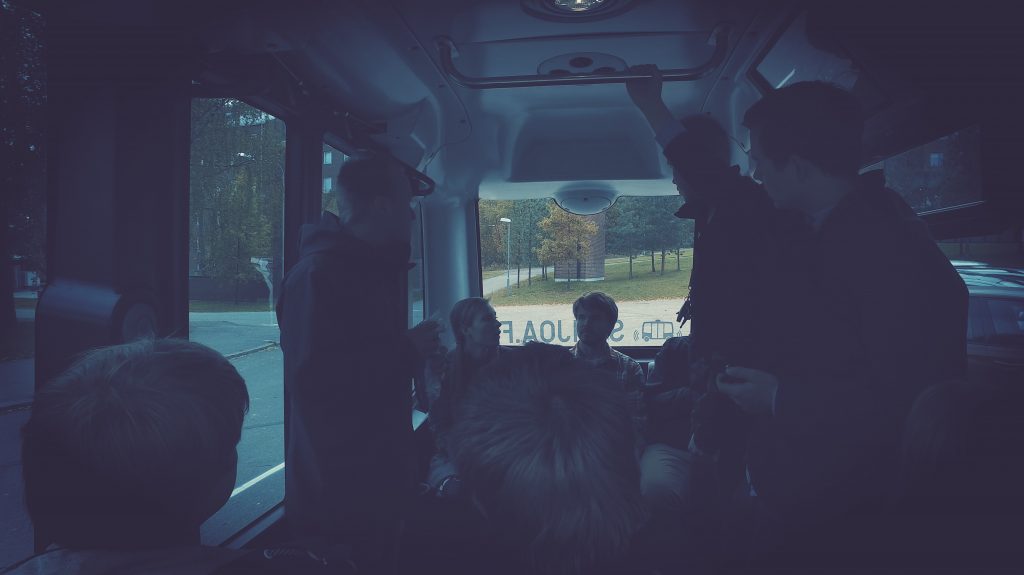A woman in her thirties is gazing at a row of computer screens in a dimly-lit room. Each screen is running a video feed from a car driving on the sunny streets of Helsinki. “I must say I’d love to have some life around me”, she sighs, and continues to…
A woman in her thirties is gazing at a row of computer screens in a dimly-lit room. Each screen is running a video feed from a car driving on the sunny streets of Helsinki. “I must say I’d love to have some life around me”, she sighs, and continues to stare at the screens. “Humming of the motor, some noise from the nearby forest. Or perhaps just the mumbling of a co-worker would do it – anything really. It’s so boring.”
What took us to this dystopian scene? Let’s take a couple of steps back. For a few years now, autonomous vehicles have been a mainstream topic. Big corporations such as BMW, Google, and Baidu are running large projects with big budgets, trying to get automatic cars out on the roads.

Mobility laboratory at Metropolia explores questions such as how many vehicles one person can adequately monitor from distance.
However, there are still key problems to solve before automatic transportation becomes a part of everyday life. For one, robot transportation is difficult to blend in with human-operated transportation. Robot cars have been involved in car crashes, and they have mostly been consequences of human error.
In Finland, a couple of relatively small players have decided to take another route, and seem to be going in a promising direction. Metropolia University of Applied Sciences, along with Demos Helsinki, a leading Nordic Think tank, have developed a radically new way of testing robot buses. Their approach is different from the big car manufacturers: they look at the human side of automatic transport, and try to apply it to automated public transport.
By running a series of bold experiments (briefly shown in the video above), the researchers at Demos Helsinki and Metropolia think they have figured out what is needed for automatic transportation to work: mutual assistance between humans and robots.
Every little helps
“As a social space, an autonomous bus is something between a bus and a subway”, says Mikko Annala, an expert of behavioural research at Demos Helsinki. That can be an advantage, as Annala points out: “As we are introducing a new space here, we can perhaps introduce new behavioural patterns too.” Before the automatization is bullet-proof, one way to smooth out complications could be to teach people new skills. That means introducing new kinds of social norms and behavioural patterns.
In the context of traditional buses, it is normal to help people with baby carriages or wheelchairs to get onboard. This kind of behaviour has become a social norm, and it is possible to teach people new kinds of norms. For example, in the future, people traveling with semi-autonomous buses could help move small obstacles from the road so that the bus can proceed. Or, as Annala puts it: “The question is whether we can create a social norm where passengers – not the driver – help the robot bus to get to where it needs to go.”
Tell me what you see
So the buses are capable of driving by themselves if they receive help once in a while. But what about the situations where the bus meets a problem that is unforeseeable or more complex?
This is where the above-mentioned operator and the row of screens become relevant. The idea is to develop a operating model that would enable one person to remotely monitor several cars simultaneously, and only intervene where necessary. Or, in the words of Harri Santamala, who is running the pilot study at Metropolia: “It will be like an air traffic control center, but for road traffic”.
The ability of human beings to function as an operator in a “road traffic control center” are still unexplored. How many buses can one person be monitoring? How quickly will she get tired and lose her attention? When we are talking about mobility, these questions are vital.
At the moment, it wouldn’t be a dream job. “To be honest, I’m not sure if I’d want this job”, Heli, a test operator in the study, says. “It is demanding and monotonous at the same time.”
This is why the model is now developed through rigorous testing. “We must be able to lighten the driver’s cognitive burden,” says Annala. For him, it’s a matter of enabling optimal collaboration between humans and a machines. “The machine observes with far better accuracy than us humans, but until now we are still way better in making difficult decisions”, Annala says. In addition to having more sound judgement, humans are better in adapting to new situations – such as rapidly changing traffic circumstances like parades, demonstrations or road accidents.
Whatever you do, experiment
Demos Helsinki and Metropolia are now conducting experiments in which the passengers are faced with various real-life situations, and their behaviour is observed. For example, a bike is left on the street, blocking the way, or someone decides to eat a smelly pizza in the crowded bus. Through these simulations it is possible to test and improve the passenger experience: how does it feel to ride a robot bus? But more interestingly, the experimentation can also lead to faster implementation of robot buses. It can bring the future closer than you think.
SOHJOA aims to set Finland in the fast lane of developing automated road transport systems. The project will create an open innovation platform that companies can use to develop new product and service ideas. The operation of automated vehicles in the Finnish environment is tested as part of the NordicWay project, funded by Finnish Transport Safety Agency Trafi and Finnish Transport Agency Liikennevirasto. The NordicWay project tackles the challenges of new traffic services and road transport automation.

